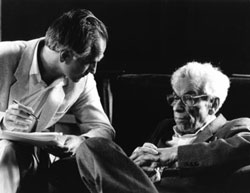|
After finishing his Ph.D. in 1934 at the University of Budapest, Erdős went to Manchester.
In England he met several of the world's leading mathematicians-G. H. Hardy, J. E. Littlewood
and Louis Mordell among them. Throughout this period Erdős continued to spend his summers in
Hungary, but in 1938 the Nazi invasion of Czechoslovakia convinced him that Hungary was no
longer a safe place for a young Jewish intellectual. He accepted a position at Princeton
University's Institute for Advanced Study, but soon moved on to other American schools.
During the war, he lost touch with his mother and most of his friends. It was only in late
1945 that a letter from his mother informed him of the relatives and friends murdered by the
Nazis. His father, two aunts and two uncles were dead and the Anonymous Group was decimated.
Because of the new Communist regime in Hungary, Erdős was unable to visit his mother until
1948-just as anti-Communist hysteria peaked in the United States-a country he calls "Samland"
(for Uncle Sam). His visits home earned Erdős an FBI interview that resulted in the loss of his
re-entry permit to the United States until the late 1950s. In Hungary, Erdős became an important
link to the West, providing a whole generation of Hungarian mathematicians access to a world
from which they had been cut off by a Communist regime imposed by the Soviet Union-a country
Erdős calls "Joedom" (after Stalin).
The tragedies of the 20th century that marked Erdős's life are often invoked in his wry humor.
Melvyn Nathanson, an American colleague, calls Erdős "the Bob Hope of mathematics," and when
Erdős brings down the house during a Cambridge lecture, we can see why. An example of the
subtle Erdős humor emerges in Erdős's rendition of "Jack and Jill," in which he substitutes
"Sam and Joe," because Jack and Jill were originally nicknames for Elizabethan politicians,
and Sam and Joe might just as well be considered their 20th century equivalents.
 During another
lecture Erdős states that most mathematicians are "a little crazy," mentioning a Hungarian
mathematician he knew in the '30s "who was a bit crazier than the average-mathematician."
The ensuing story is a masterpiece of wit and compassion. During another
lecture Erdős states that most mathematicians are "a little crazy," mentioning a Hungarian
mathematician he knew in the '30s "who was a bit crazier than the average-mathematician."
The ensuing story is a masterpiece of wit and compassion.
Erdős gave his life to mathematics, yet his concerns were deeply human and ethical.
"Mathematics is the metaphysics of modern man..." wrote Time Magazine's Charles Krauthammer.
"Erdős, an agnostic, likes to speak of God having a book that contains the most elegant,
most perfect, mathematical proofs." Erdős's obsession with unsolved problems was a lifelong
struggle with the petulant deity he liked to call the SF-the Supreme Fascist. His goal was to
uncover a few pages of the SF's transfinite book.
Unsolved problems, rather than neatly packaged theories, were Erdős's territory. Instead of
spending their time at computers, the mathematicians in "N is a Number" work during meals and
long walks, breaking for a game of ping pong, or a coin trick. To stimulate younger colleagues,
Erdős offers cash prizes for the solution of the most intractable problems.
Mathematics is described as a giant search engaged in by many people working together on the
same questions over the centuries. Tomasz Luczak, an important young Polish mathematician, talks
about sudden flashes of inspiration and Erdős's unusual intuitive talents. Cambridge mathematician
Béla Bollobás likens the quest to sculpting, even as his wife works on a bust of Erdős.
Joel Spencer of the Courant Institute at NYU wonders what lies behind the stimulating
questions Erdős asks, because "by asking these questions, mathematical theories have been
developed." All of the mathematicians in the film agree that math is a fluid, on-going search
for absolute truths which lie just over the horizon.
Interviews and scenes of Erdős lecturing and working with others were filmed at the
University of Pennsylvania (1988), in San Francisco (1989), at Princeton, Rutgers, AT&T Bell
Labs, Bellcore and other locations in New Jersey (1991), and at the Random Graphs conference
in Poznan, Poland (1989). In Poznan, mathematicians compete in the Random Run-a foot race run
according to rules based on Erdős's radical ideas on randomness. Additional interviews with
Erdős and his colleagues were filmed in Hungary (1989), and on the occasion of the Cambridge
University honorary doctorate ceremony in England (1991).
|